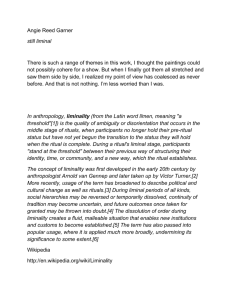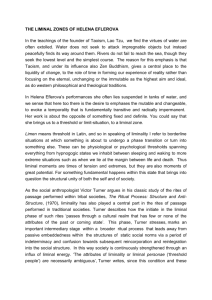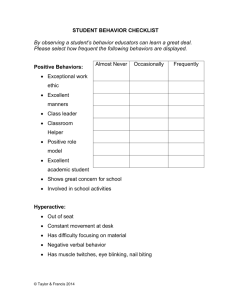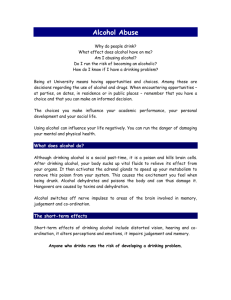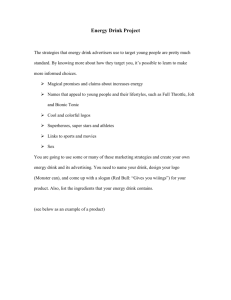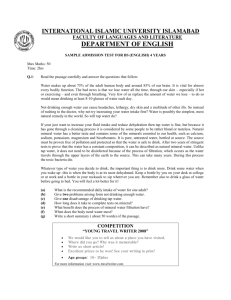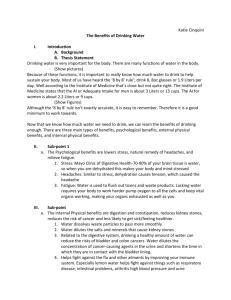Chapter 5 PowerPoint
advertisement
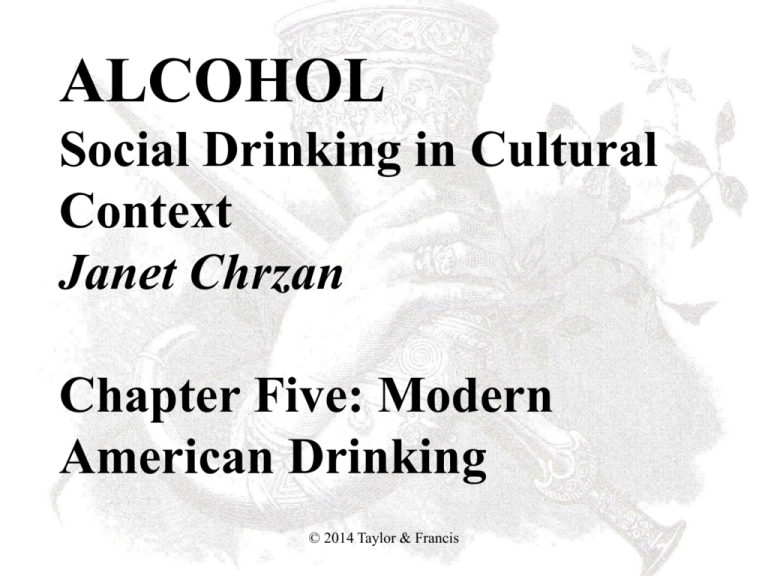
ALCOHOL Social Drinking in Cultural Context Janet Chrzan Chapter Five: Modern American Drinking © 2014 Taylor & Francis Work is the curse of the drinking classes. Oscar Wilde Temperate temperance is best. Intemperate temperance injures the cause of temperance. Mark Twain If all be true that I do think, There are five reasons we should drink; Good wine—a friend—or being dry Or lest we should be by and by— Or any other reason why. Henry Aldrich, Dean of Christ Church, Oxford 1689 © 2014 Taylor & Francis How can we think about the cultural spaces that permit alcohol use? 1. Time-use patterns (day, week, year and culturally determined rest/vacation vs. work periods) 2. Status and Rank (gender, age, role, hierarchy) 3. Life stage 4. “Insider” vs. “Outsider” status © 2014 Taylor & Francis Time-Use Patterns: Day and Week Exercise: Plot out your day using this table, making one schedule for a weekday and one for a weekend day. Where in your time map can you drink alcohol without facing social censure? © 2014 Taylor & Francis Time-Use Patterns: Month Exercise: Plot out your typical month using this table. Where in your time map can you drink alcohol without facing social censure? Sun Mon Tue Wed Thu Fri Sat 1 2 3 4 5 6 7 8 9 10 11 12 13 14 15 16 17 18 19 20 21 22 23 24 25 26 27 28 29 30 31 © 2014 Taylor & Francis Time-Use Patterns: Year Exercise: Plot out your year using this table, with special attention to holidays and vacations. Where in your time map can you drink alcohol without facing social censure? © 2014 Taylor & Francis January S M February T W T F S 1 2 3 4 5 S M T W March T F S 1 2 S M T W T F S 1 2 6 7 8 9 10 11 12 3 4 5 6 7 8 9 3 4 5 6 7 8 9 13 14 15 16 17 18 19 10 11 12 13 14 15 16 10 11 12 13 14 15 16 20 21 22 23 24 25 26 17 18 19 20 21 22 23 17 18 19 20 21 22 23 27 28 29 30 31 24 25 26 27 28 24 25 26 27 28 29 30 S 31 April S May M T W T F S 1 2 3 4 5 6 S M 7 8 9 10 11 12 13 5 6 14 15 16 17 18 19 20 12 21 22 23 24 25 26 27 19 28 29 30 26 T June W T F S 1 2 3 4 S M T W T F 7 8 9 10 11 2 3 4 5 6 7 8 13 14 15 16 17 20 21 22 23 24 18 9 10 11 12 13 14 15 25 16 17 18 19 20 21 22 27 28 29 30 31 23 24 25 26 27 28 29 1 30 July S August M T W T F S 1 2 3 4 5 6 S M T W September T F S S M T W T F S 1 2 3 1 2 3 4 5 6 7 7 8 9 10 11 12 13 4 5 6 7 8 9 10 8 9 10 11 12 13 14 14 15 16 17 18 19 20 11 12 13 14 15 16 17 15 16 17 18 19 20 21 21 22 23 24 25 26 27 18 19 20 21 22 23 24 22 23 24 25 26 27 28 28 29 30 31 25 26 27 28 29 30 31 29 30 S October S M November T W T F S 1 2 3 4 5 S M T W December T F S S M T W T F 1 2 1 2 3 4 5 6 7 6 7 8 9 10 11 12 3 4 5 6 7 8 9 8 9 10 11 12 13 14 13 14 15 16 17 18 19 10 11 12 13 14 15 16 15 16 17 18 19 20 21 20 21 22 23 24 25 26 17 18 19 20 21 22 23 22 23 24 25 26 27 28 27 28 29 30 31 24 25 26 27 28 29 30 29 30 31 How do Status and Rank determine who can drink without facing cultural censure? 1. Gender (thought exercise) What do you think when you see: – a woman drinking? – a man drinking? – a young woman drinking? – a young man drinking? – a middle-aged woman drinking? – a middle-aged man drinking? – an old women drinking? – an old man drinking? – a transsexual or cross-dressing man or woman drinking? © 2014 Taylor & Francis How do Status and Rank determine who can drink without facing cultural censure? 2. Age (thought exercise) What do you think when you see: – beer being put in a baby’s bottle? – a child being given a sip of a parent’s drink? – a 12 year-old trying a beer? – a teenager drinking a martini? – a 20-something with a pint of beer? – a 40 year-old drinking alcopop? – a grandparent with a “cold one” in hand? – an older couple sharing a bottle of wine? © 2014 Taylor & Francis How do Status and Rank determine who can drink without facing cultural censure? 3. Role (thought exercise) What is the most respectable job someone can do? The least respectable? Can you rank professional activities in order of respectability within your culture? How does being a member of one of these categories alter the appropriateness of using alcohol? Does it dictate how, when, and where such a person can or should drink? If so, how? © 2014 Taylor & Francis How do Status and Rank determine who can drink without facing cultural censure? Image source: Gabrinus (the Roughwood Collection). Used by permission of William Woys Weaver. 4. Hierarchy (thought exercise) Does being high status or low status affect who can drink? What is a high status role or person? What is a low status role or person? Is status assigned (you are born with it) or achieved (a something you earn or make for yourself)? Does gaining status through birth or effort alter one’s “right to drink”? Should a high status person drink with a low status person? Why or why not? Can someone have high status but low respectability and, if so, how does that affect their right to drink? Should people who are high status and highly respectable drink? Why or why not? © 2014 Taylor & Francis How does Life Stage determine who can drink without facing cultural censure? What are the recognizable life stages in American culture and how do they affect who can drink alcohol? How do we know when one stage is ended and the next begun? – infancy/toddler – childhood – teen – college student – young worker/young adult – pregnancy/post-partum – parent/middle-aged adult – elderly. © 2014 Taylor & Francis Image source: Albert Roosenboom [Public domain], via Wikimedia Commons How does Insider/Outsider status and Liminality determine who can drink without facing cultural censure? Webster’s 1913 Dictionary: Liminal (adj.) 1. Of or pertaining to a limen, especially a sensory threshold. 2. Marginally perceptible. 3. (Anthropology) That temporary state during a rite of passage when the participant lacks a social status or rank, is required to follow specific forms of conduct, and is expected to show obedience and humility. © 2014 Taylor & Francis Definition: Liminal Space Psychologists call “liminal space” a place where boundaries dissolve a little and we stand there, on the threshold, getting ourselves ready to move across the limits of what we were into what we are to be. Building on Mircea Eliade’s concept of division of human experience in sacred and the profane, Victor Turner introduced the concept of “liminal space”: a space of transformation between phases of separation and reincorporation. It represents a period of ambiguity, of marginal and transitional state. Similarly does Arnold van Gennep, while describing rituals of transition. For Gennep, liminal or threshold world is a space between the world of status that the person is leaving and the world of status into which the person is being inducted. In post-colonial studies, for Edward Said, but especially for Homi Bhabha, the liminality is important as a category strongly related to the concept of cultural hybridity. For Bhabha, liminal as an interstitial passage between fixed identifications represents a possibility for a cultural hybridity that entertains difference without an assumed or imposed hierarchy. The concept of liminality as a quality of “in-between” space and/or state is of the outmost importance in describing some of the most interesting and highly specific social and cultural phenomena: the trans-cultural space, the trans-geographical space, the transgender space, etc. Sharon Zukin transferred the term in urban studies, saying that liminal space is a growing character of contemporary city: she argues that the localism, or neighborhood urbanism, of the modern city has been transformed into postmodern transitional space. This space is “betwixt and between” economic institutions but is best described by the adjective liminal because it complicates the effort to construct identity. Liminal spaces are ambiguous and ambivalent, they slip between global market and local place, between public use and private value, between work and home, between commerce and culture. http://www.liminalartsnetwork.co.uk/Resources/Liminal_definition.pdf © 2014 Taylor & Francis Definition of Liminality (Wikipedia) In anthropology, liminality (from the Latin word līmen, meaning (“a threshold”) is the quality of ambiguity or disorientation that occurs in the middle stage of rituals, when participants no longer hold their pre-ritual status but have not yet begun the transition to the status they will hold when the ritual is complete. During a ritual’s liminal stage, participants “stand at the threshold” between their previous way of structuring their identity, time, or community, and a new way, which the ritual establishes. The concept of liminality was first developed in the early 20th century by anthropologist Arnold van Gennep and later taken up by Victor Turner. More recently, usage of the term has broadened to describe political and cultural change as well as rituals. During liminal periods of all kinds, social hierarchies may be reversed or temporarily dissolved, continuity of tradition may become uncertain, and future outcomes once taken for granted may be thrown into doubt. The dissolution of order during liminality creates a fluid, malleable situation that enables new institutions and customs to become established. [ http://en.wikipedia.org/wiki/Liminality Definition of a Liminal Culture A liminal culture exists only minimally and at and for the moment. Liminal cultures appear and disappear as people move from one cultural identity to another, or consist of people or groups that have never been able to establish a clear social and cultural identity in their setting. See also minimal rationality. http://www.religion.emory.edu/faculty/robbins/SRI/defns/j_l_defns.cfm © 2014 Taylor & Francis How do we visualize or think about Liminality and Insider/Outsider status? Graphs? Diagrams? Relationship trees? Time? Space? Status? Rank? © 2014 Taylor & Francis Image provided by University of Georgia (University of Georgia photo services) [Public domain], via Wikimedia Commons. How do we visualize or think about Liminality and Insider/Outsider status? The Daily Schedule: There are times within a day when there is “free time” either because someone is in between time periods (going to and from class, to and from work, etc.) or because there is nothing scheduled (after work, relaxation, etc.) Are one or both of these periods “liminal”—and why or why not? If these periods aren’t scheduled, and if they are or are not liminal, can one drink alcohol without being labeled a problem drinker? The Calendar Year: Are there periods within a year in which your time is free or unmarked for a particular activity? Or a time between other scheduled events/periods, such as between the end of classes and the start of finals, when time use is ambiguous? Does that ambiguity alter how you view the appropriateness of drinking alcohol? The Life Cycle: Are there periods in a life in which time use is not strongly governed or where the status and role of the person is ambiguous? And do these periods generally allow for intoxicant use or discourage use? © 2014 Taylor & Francis How do we visualize or think about Liminality and Insider/Outsider status? Social Roles: Are there social roles or social groups that are considered to have “outsider” status? Are there social roles or social groups that are considered “insider” and integral to the functioning of society, economics, and cultural life? How can a role or group be considered “liminal,” and if so, does that characterization alter how that person or group is expected to use intoxicants? Professional/Work Roles: Are there types of jobs that are “liminal,” or that are considered marginal, or not very respectable? Are there jobs that are considered to be core economic roles and essential to the functioning of the society? Can you place a series of jobs into a hierarchy of least to most respectable? Does that hierarchy govern any expectations about alcohol use by people who have those jobs? Ascribed Roles: Are there types of people who are never fully in (or out) of a culture? People who really don’t belong, according to cultural notions of in-group vs. out-group categories? What ascribed roles or status are considered very respectable, or very important to a culture? What in an example of an ascribed liminal status? And does that status characterization affect how that person’s use of alcohol is viewed? © 2014 Taylor & Francis How do we visualize or think about Liminality and Insider/Outsider status? If you drink, think back to the last time you might have had “too much.” What were you doing? Why did you drink that much? What time were you drinking? What day? What month? What was your reason for having “too much?” Were you in a liminal state—in between scheduled tasks or were you celebrating during leisure time, or time off? Were you on vacation? Were you someplace new, or traveling through someplace? (“What happens in Vegas stays in Vegas.”) Did you feel good or bad about your over-indulgence? Did you receive any criticism for being drunk? Did friends or family tease you or chastise you for getting tipsy? Or did they rationalize your intoxication … and if they did, what was their argument for drunkenness being acceptable? How did you know how to act while drunk? © 2014 Taylor & Francis Image by Landii [CC-BY-SA-2.0 (http://creativecommons.org/licenses/by-sa/2.0)], via Wikimedia Commons. Drunken Comportment: A Social Explanation From MacAndrew, Craig, and Edgerton, Robert B. (1969). Chicago, Aldine Publishing Company, p169 . “[I]f people have been brought up to believe that one is ‘not really oneself’ when drunk, then it becomes possible for them to construe their drunken changes-for-the-worse as purely episodic happenings rather than as intended acts issuing from their moral character. So construed, not only can the drinker explain away his drunken misbehavior to himself (‘I never would have done it if I had been sober’), those around him can decide, or be made to see, that his drunken transgressions ought not—or at least, need not—be taken in full seriousness (‘After all, he was drunk’). We are arguing, then, that the option of drunken Time Out affords people the opportunity to ‘get it out of their systems’ with a minimum of adverse consequences.” © 2014 Taylor & Francis Anthropology and Alcohol: Discussion Questions Gusfield argues that drink stands as an icon for leisure in America. What elements of industrial life, his arguments and why? Why would an industrial schedule, even one that does not promote horrific working conditions, engender the kind of drinking patterns we see in America today? Why might employers want their workers not to drink, even off the job? How is compartmentalization an important aspect of the structure of the industrial work world? How does this process interact with the social processes of drinking behavior to promote certain kinds of behavioral outcomes in drinking? What kinds of social functions does a time-out period promote? How does a social ritual like “spring break” help to define social identity, and to socialize young people? Do you know of any other religious and/or cultural traditions that have such periods of liminality and reversal and, if so, how do they work and what is their outcome for the social group in question? What might be some explanations for the line between that which is sacred and godly and that which is often associated with excess and loss of control, especially where alcohol use is concerned? What does loss of control mean … personally, physically, and socially? What are the American beliefs about control? Why is use of time such an important element in our ideas about control? What are beliefs about time use and control? © 2014 Taylor & Francis
